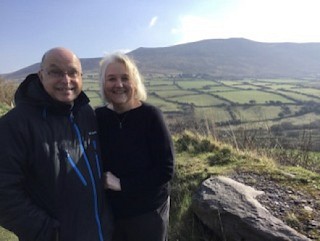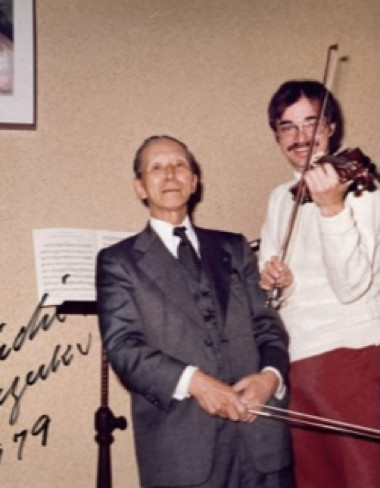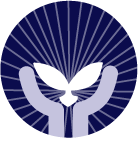Roger and Linda Stieg

Roger Stieg received his Bachelor of Science in Music Education from Indiana University of Pennsylvania and his Masters in Violin Performance from Michigan State University. Additionally, he received a Suzuki Teacher Training certificate after two years of study under Dr. Suzuki in Matsumoto, Japan and is a certified Suzuki Teacher Trainer.
Roger has retired from the Columbus Public Schools string orchestra program after 37 years of teaching and currently teaches applied violin and viola at Ohio Christian University. Roger also is actively involved in Suzuki Music Columbus. Roger is the co-founder of the Youth Philharmonic of Central Ohio and the Ohio Christian University Chamber Orchestra.
Roger is a sought-after master teacher and clinician as well as a teacher trainer at workshops and summer institutes throughout the year and regularly featured at the summer institutes at Otterbein University and the Indiana Arts and Music Festival in Indianapolis.
Roger was a member of a string quartet that did 3 concert tours in Japan. He also took the Ohio Christian University Chamber Orchestra to Japan in 2016 and 2017, performing concerts in Karuizawa as well as Matsumoto.
Roger has a unique perspective of teaching not only from Dr. Suzuki but also teaching his children 4 times over and working with his 7 grandchildren.
Linda Stieg received her Bachelor of Science in Music Education from Indiana University of Pennsylvania and her Masters in Kodaly from Capital University. Additionally, she received a Suzuki Teacher Training certificate after two years of study with Dr. Suzuki in Matsumoto, Japan and is a certified Teacher Trainer. She also has a certificate in Teaching English as a second language (TESOL). Linda started and developed an orchestra program in the Pickerington Public Schools in Pickerington, Ohio and is the co-founder of the Youth Philharmonic of Central Ohio. Linda recently retired from the public schools but is actively involved with Suzuki Music Columbus, and teaches a string method class and violin lessons at Ohio Christian University. She has performed in a string ensemble with the Ohio Christian University that recently traveled to Japan in 2016 and 2017. Linda is a sought-after clinician for Suzuki workshops and summer institutes and is a regular at Otterbein University and the Indiana Arts and Music Festival in Indianapolis. She currently is teaching violin to her 7 grandchildren.
Memories
Roger and Linda Stieg: Memories of Matsumoto and Dr. Suzuki
This was an incredible time of reflection for us as we went down memory lane with Dr. Suzuki. We’ve often reminisced but writing it down was an emotional experience for us. Roger was working on his master’s in performance at Michigan State University while Linda had a violin teaching job in the public schools and was taking master classes in violin pedagogy at Michigan State.
There was a Suzuki program in a local community run by Marilyn Kessler, and they were having a weekend workshop. Linda thought, as a teacher, she should see what other schools were doing. She was shocked when experiencing her first encounter with the Suzuki Method. How could a stage full of students look so confident and have such control of their instruments? How could this be?
She ran home to get Roger. He was practicing for his recital, but being newly married, he bent to her insistence. When we heard the students play, we were stunned. The musicality, confidence and facility were beyond anything we had experienced.
This was the birth of our Suzuki journey.
We immediately contacted Marilyn and started observing her teach. Then we signed up for every summer workshop we could schedule. On our way to one of the workshops, we had the thought...Why not study with the Master himself? So, we decided to pack our bags for Japan to attend the Talent Education Institute in 1977. We ended up studying there for two years.
When we arrived in Japan, we expected classes to be laid out in a systematic form as they were at home. But this world was completely opposite of the learning style we had left. There were classes where we would practice writing in Japanese to train our bow arm. The tip of the brush and elbow were to have the same motion. We also had weekly group lessons where we just did bow exercises and played something from the Suzuki books.
There was also one master class a week with Dr. Suzuki. Here we often experienced what it meant to have a one-point lesson. There was no time frame for a lesson. Some lessons were a few minutes, others longer. His strength was giving you just what you needed to improve. Lesson time was filled playing your piece then he’d concentrate on tonalization. We’d play a piece for him, and he’d usually ask a question. I remember him saying, “Do you like your up bow or down bow?” and “International intonation, please.”
And how many times did we hear, “Do you like sand? I hear sand.”
Our brains were full of questions. How were we to learn phrasing, fingerings, where to put the dynamics, how to do this shift effectively? There seemed to be no focus on the techniques of how to play. How could we improve? The master would just hear your piece, do bow exercises and totalization, then give one comment.
We arrived with extensive training. Roger had a master’s in performance, and Linda had experience teaching and had many classes in pedagogy. Was this worth all the money and time we had sacrificed? As we began to grow, we learned how little we really knew.
At first, we couldn’t understand why our playing was improving if we weren’t concentrating on phrasing or technique. It seemed Dr. Suzuki wasn’t teaching us anything except doing bow exercises and one-point lessons. There had to be more to this.
Then we would hear the young students. They played so well, so confidently, so solidly. Obviously, we were missing something. Dr. Suzuki was making us learn the method through the method. We were immersed in the environment. There weren’t any practice rooms to be found. We’d all practice in one room. How brilliant! We’d see and hear others practicing their section 10,000 times...Yes, really!
After six months, things started to make sense. We became the active learners as we adapted to the environment. We listened to others working on their pieces, heard their lessons, learned to teach ourselves instead of being spoon fed. We had to find the answers ourselves. Dr. Suzuki wasn’t going to enable us.
We also observed other teachers at the school teaching young student lessons. We watched the same students progress through two years of study. We’d hear other teachers give instruction. But the element that made the method different was the Suzuki way of cultivating the environment. Group lessons, expectations, listening. All these combined to cause learning.
Here’s an example of Roger’s lessons with Dr. Suzuki. He played the same piece for three months. Each time, Dr. Suzuki would say, “Use whole bow please.” Finally, Dr. Suzuki took his beautiful bow and slid it across the floor from one side of the room to the other, repeating, “Use whole bow please.” He made his point. This encouraged us to carefully observe others practicing. He taught you to look for the answers and learn. We were challenged to go to other students to ask what he was trying to say. He’d teach you to listen to a recording by saying, “Suzuki lessons expensive, recording is free.” We found we could hear the bowings, fingerings, dynamics, phrasing, and musicality through the recordings of master performers.
We had weekly recitals where everyone would perform. Linda was so nervous about performing. She found safety in playing the same piece for months. Her tone and playing had improved so much by performing the same piece week after week that Dr. Suzuki made a new rule that everyone should play the same piece at least twice so everyone could hear the improvement.
When he saw us perform and something needed to be fixed, he periodically would come on stage and fix it. Sometimes it would be a violin sagging and he would stand like a light post at the scroll and hold the instrument up. In Linda’s case, her bow arm was up too high for his satisfaction. He came up and stood where her arm was, holding it down. What he seemed to not recognize was she was 9 months pregnant. Chuckles came from the audience, and I think he thought the chuckles were for him and his clever way of fixing a problem. I’m still not sure what went on...all she knew was her bow arm wouldn’t go down because of her stomach!
After our son was born, we brought him to lessons. One day he was sitting in front of a sketch of Pablo Casals. Our son had the same expression as the sketch, a protruding lower lip and a stare. Suzuki called him Pablo-chan. Chan is a name for children, so this name held as our son’s nickname.
A famous orchestra from Europe came to Japan to play a concert series. They sent a quartet to play a concert at our school. The next day as we observed Suzuki teach, two members of the quartet came in to watch. At first, we were impressed that they took the time to support and observe Suzuki. This turned to surprise as they started to criticize his teaching directly to his face. We were curious to see what Suzuki’s reaction would be. He just bowed and smiled.
It was especially impressive to me that after the quartet left, he didn’t talk about them or try to defend his philosophy or protect his ego. He was so confident, he knew his way worked, regardless of any criticism he received.
A while before this happened, he told us that at some point in his life, he had become very angry, and he promised himself he would never become angry again. I’ve heard other students talk about this vow, and we all saw him uphold it. Our lessons continued without any wavering in his philosophy or methods. He kept teaching and smoking his Camel unfiltered cigarettes - business as usual.
With difficult subjects, his demeanor was the same. Politics never entered the studio or any of his conversations. He’d smile and bow and keep the focus on his students. He never was one to breed hatred or tell us how smart he was or how stupid anyone else was. He always stayed in character, and that character was truly inspiring.
He had love, patience, and kindness for every student, and never gave up on anyone. He had the best intent for others in all his actions. Dr. Suzuki was a great inspirer, a salesman of dreams. One couldn’t resist or say no to those dreams. You couldn’t help but be seduced by his belief in you. A poor self-image simply could not exist in his environment. His belief in you was irresistible. This changed the course of our lives. If we had one sentence to sum up Dr. Suzuki, it would be, “Watch and learn.” This was his comment to us throughout our stay. He had discovered life and teaching through a keen God-given perception. He was ahead of his time.
People would come and try to explain to him why his ideas worked, but each time he would simply bow. He told me, “I just know it works.” He wasn’t interested in all the theories and research. Again, he’d repeat to us, “Watch and learn.”
When one famous group came, their tone was airy and fuzzy. We were all wondering what he’d say; we were sure he’d comment. When he didn’t say anything, we asked what he thought about their performance. He just said, “Watch and learn.”
Today, knowing much more about theories of teaching and language development, and recognizing how far ahead of his time Dr. Suzuki really was, we find that everything supports his Ability Development and Talent Education philosophy. He was wise and kind. He truly believed talent could be educated.
Dr. Suzuki’s teaching was radical in his time. Many traditional teachers were condescending and taught for the benefit of their ego. By contrast, Suzuki was open and kind, which often caused him to be misunderstood. Many traditional teachers were protective of their information and wouldn’t share their ideas. They taught through intimidation and competition. Suzuki was generous to anyone who wanted to learn.
He was humble and had an open spirit. He was willing to share his knowledge because he believed through doing so, we could all grow better together. This was his message: “To create a better world for all of us.”
Others taught the violin, but Dr. Suzuki taught the human spirit.
We’ve been teaching for about 50 years and have done our best to pass on Dr. Suzuki’s legacy. He’s the one who said, “If you’re a good teacher, your students will be better than you.” You are his student. “Watch and Learn.”
Photos in Matsumoto

Linda Stieg

Roger Stieg

